Socialization, development of imagination, and consequent creativity, are just some of the contributions of the Popular games that we have below that anyone can do at home or, who knows, in Education classes Physics.
1. undead
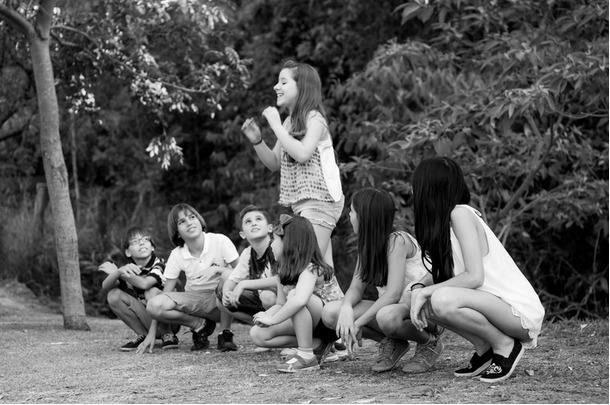
It doesn't matter the number of participants. In the game of the Undead it is only necessary that someone is responsible for giving the commands to the children.
To make it easier to see who is wrong, participants should line up, facing the child who is chosen as the leader, who will give the commands: "dead", when everyone must crouch, and "alive", when everyone must crouch rise.
The difficulty increases according to the speed and sequence dictated by the leader. Who makes a mistake, leaves the game, and the participant who doesn't make a mistake wins, occupying the position of leader in the next round.
2. Wireless phone

Preferably in a row, one next to the other, the children transmit a message in the ear of the nearest child.
The message can be a word or phrase chosen by the person at the tip, or suggested by someone else. Once the game is started, the participants have to say the chosen message in the ear and transmit it to whoever is next to them.
If someone doesn't understand the message well, they have to say it anyway, since it cannot be repeated. Messages are usually modified throughout the game, and the latter speaks out loud the final result.
3. Statue
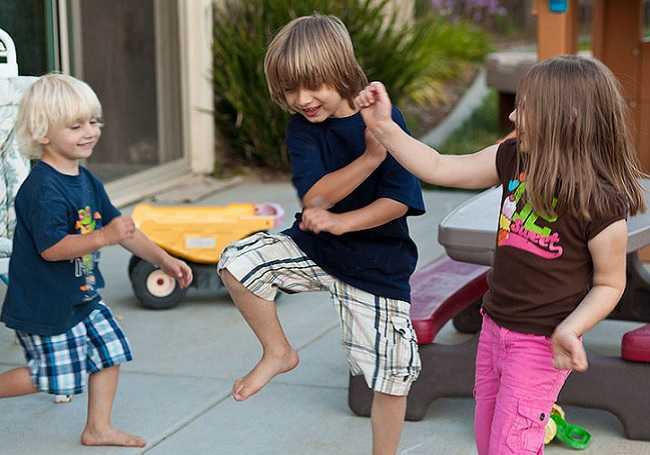
In the statue game you have to dance and stop when the music ends.
The children randomly position themselves and dance to the music, but when the music is stopped, the participants can no longer move, remaining in the way they were at the time the music stopped.
After that, whoever coordinates the game has to go through the participants evaluating who remains immobile like a statue. That person can just walk between the participants or talk to them and make faces trying to get them to move.
Whoever moves, leaves the game. Whoever stays for the end wins.
4. Detective
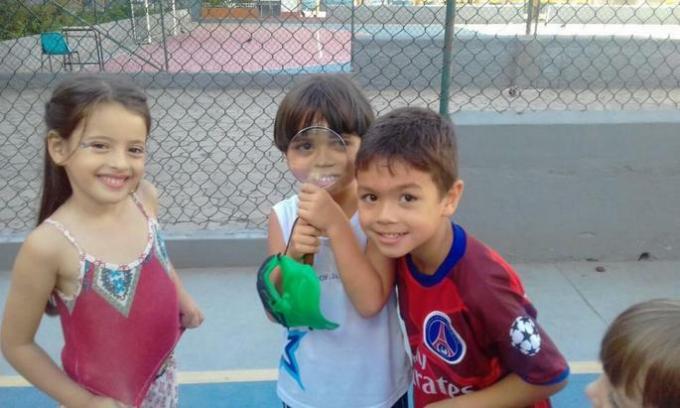
Write on one piece of paper the word "detective", on another "thief" and, according to the number of participants, write small pieces of paper with the word "victim".
Draw a lot and then organize the children in a circle, sitting or standing, for the game to begin.
Thus, the participant who took the role of thief has to take a risk and wink at the other participants - one at a time - to try to kill them, but without being noticed.
If the participant the thief blinks at is a "victim", he will say "died", but if he is the "detective", the thief is discovered causing the game to end.
5. Chair dance

To do the chair dance, we're going to need one less chair than the number of participants.
Chairs should be arranged in a circle or facing away from each other in two rows.
With the help of music, the children start to run in a row around the chairs until someone stops or turns the music down and each participant tries to get a seat.
The participant who remains standing, leaves the game and, with his departure, a chair also leaves until the end of the game. The last one is the winner.
6. Hot or cold

Someone hides an object that will be searched for by the other participants. As a child approaches the location where the object was hidden, the commander says "hot", but conversely, the farther away, says "cold".
The commander can help further by saying "it's getting hot" or "it's so cold it's freezing."
Whoever finds the object, starts to command the game next time.
7. Silly

In Bobinho game, children pass a ball by the others without letting a child in the center of them catch the ball in the air.
The participant in the center is the "jester", who can spend a lot of time among the others without being able to catch the ball.
This game can be done with several children in a circle, with the "silly" at its center, but also with a minimum of three participants.
If he manages to catch the ball, the "jester" gives way to the participant who threw the ball but allowed it to be caught.
8. slaves of job
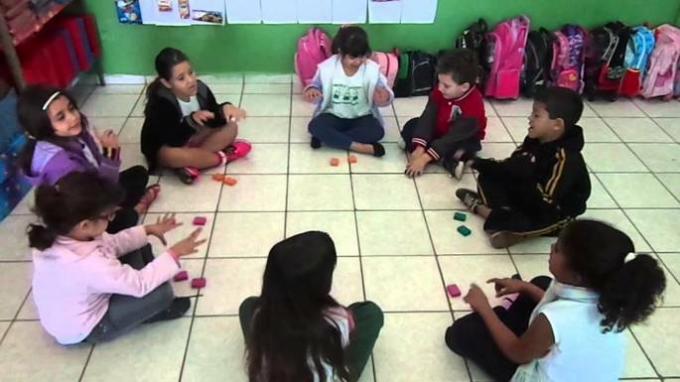
At the sound of Slaves of Job, sitting in a circle and in possession of similar objects (pebbles or small cups, for example), the children pass the objects to the child beside them.
When singing the word "strip", the child lifts the object from the ground, then, following the verse, "boots", returns the object to the ground, and when "let it stay", the child passes the object back to the person next to him. side.
In the "zigzah", from the verse "Warriors with warriors make zigzigza", the child passes the object forward and back without letting go. The game is fun and well paced.
slaves of job
They played caxangá
take it off, leave it on
Warriors with warriors zigzigzah
Warriors with fighters zigzigza.
See the texts we have prepared for you:
- Wheel games
- Folk Songs: Brazilian Folk Songs
- Most popular circle songs in Brazil
- Circle songs to play with children
9. Mirror

In pairs and positioned randomly in a space, children have to imitate the movements of whoever is in front of them, as if one were the mirror of the other.
A child can be chosen as a leader and will be responsible for evaluating who can best imitate the child in front of them.
Whoever can be more faithful to their partner's gestures wins.
10. rope dance
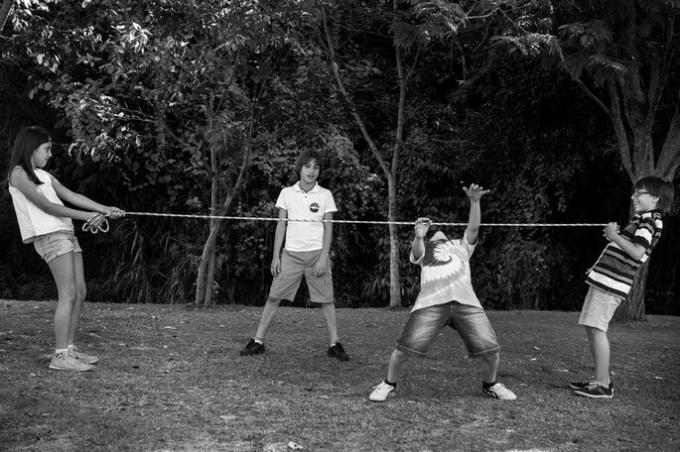
In this game, two children (one at each end) hold a rope for the other participants to pass one at a time in a row.
The game can be played with or without music. Children cannot pass in any way, just forward and leaning back without touching the rope.
After everyone passes, the height of the rope drops a little more, which increases the difficulty of the game.
Whoever can pass at the lowest height without touching the rope wins.
11. Hot potato

In a circle, preferably sitting, the children pass an object, the hot potato, to the child beside them.
Whoever is in charge of the game can have his back to the participants, or in the center of the circle with his eyes blindfolded. The passage of the potato is made to the sound of the phrase, which is sung: "Hot, hot, hot, hot, hot, hot potato... ". As long as the commander repeats the word "hot", the potato continues to be passed by the participants.
Whoever has the "potato" at the moment the song ends with the word "burnt", abandons the game.
Whoever can stay for the end wins.
12. serious game

In the game of seriousness, you have to contain the laughter.
In pairs, one child facing the other has to make the other laugh while remaining serious. It's worth making faces to try to distract the other participant.
Whoever manages to remain serious even after having done so much clowning wins.
13. Burned
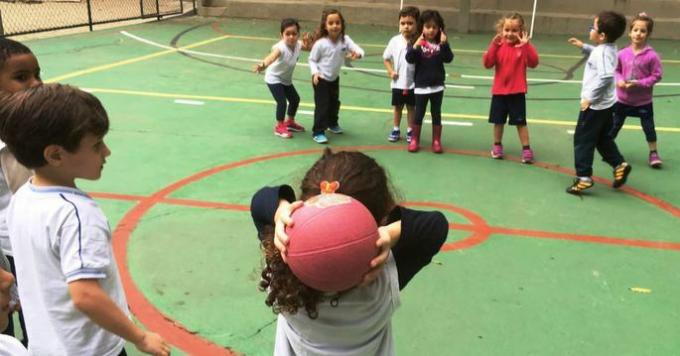
Divided into two groups, each team occupies one side of a field called the "battlefield", whose middle must be marked with a scratch on the ground.
With a ball, the children try to hit the participants of the opposing team. Those hit are "burned" and exit the game.
When one team throws the ball, the other has to try to hold it and then send the ball to the side again. opposite the field to try to hit the opponents, or you have to try to escape the ball without leaving the limits of the field.
Whoever comes last wins, that is, whoever is not "burned".
14. jump elastic
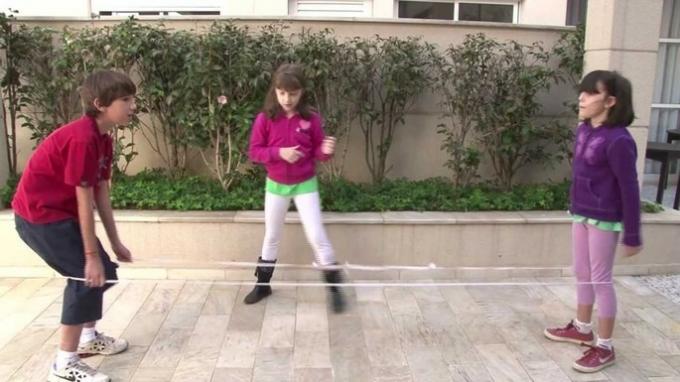
For this game you need a rubber band of at least 3 meters tied at the ends and at least three participants.
Two children place the elastic around their ankles and stand apart to keep it taut in the shape of a rectangle. Another child tries to jump the rubber band, in and out, without getting tangled up in it.
Various movements are made with the elastic, jumping and crossing it between the feet. The difficulty increases as the height of the rubber band increases throughout the game.
See too: Cooperative games: what they are and examples.
15. stop

On a sheet of paper, children should make columns with the themes they want to fill in throughout the game (name, color, fruit, car, object, country, among others). One of the columns must be reserved for the sum of the points.
Before each match they say "stop", and each participant shows as many fingers as they want. The number of fingers corresponds to the respective letters of the alphabet: 1 is A, 2 is B, and so on.
Once the letter is known, children begin to fill in each item on the list with a name starting with that letter. Whoever finishes filling in first shouts "stop" and the rest stop writing.
At the end of each game, the points are added up, each of the filled items is worth 10, but if someone has filled in with the same name, the item is worth 5 points.
Whoever has the most points wins.
Folklore Quiz
See too:
- Indigenous games to amuse children
- 15 fun games and games
- Physical Education Activities
- dodgeball game


